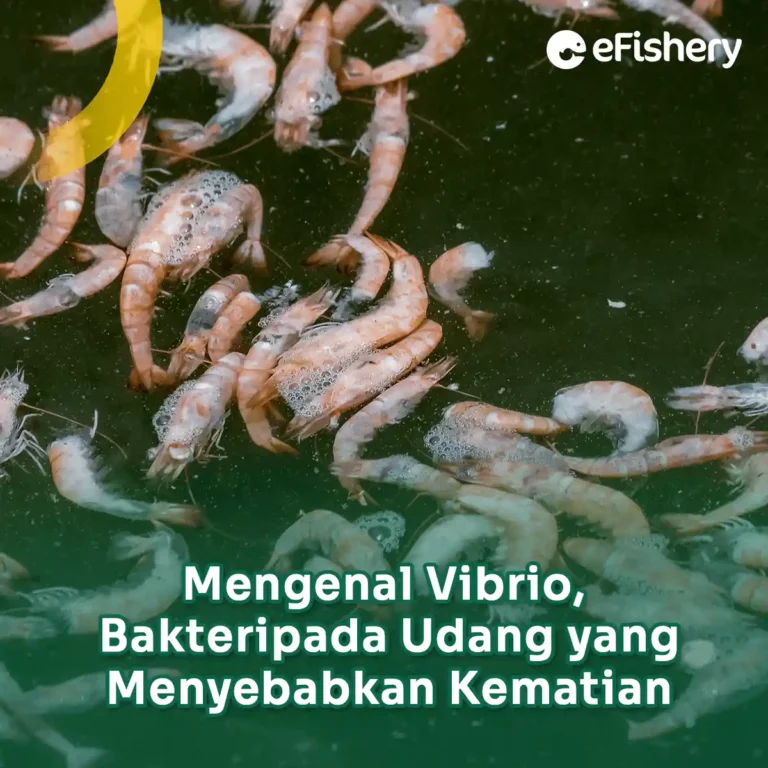Artikel Ini Telah Direview Oleh:

Anggie Nur
Magister Bioteknologi
Farmers sometimes face obstacles in water quality which changes every season. This resulted in the growth of bacteria in the shrimp. Many techniques are used by shrimp farmers to maintain water quality every season so that the pond media is not easily exposed to bacteria that kill shrimp.
One of the bacteria in shrimp that causes mass death is vibrio bacteria. Among shrimp farmers, this bacteria really haunts shrimp farming anywhere, especially farmers who don't pay attention to water quality and only play on intuition or experience.
Curious about how to easily prevent vibrio bacteria? Check out the explanation below.
Get to know Vibrio Bacteria
Vibrio bacteria are bacteria that do not have a cell nucleus and are in the form of a curved axis with one flagellum at the cell poles. Vibrio bacteria tend to live at temperatures of 8-37°C and multiply quite quickly at temperatures of 0-8°C. The life cycle of this bacteria can cause the shrimp to get sick during the molting period, when the shrimp are at their weakest.
These vibrio bacteria include opportunistic pathogens that can develop more in ponds. Worse can happen when the pond's environmental conditions change significantly (temperature, pH, DO, etc.) causing the shrimp to become infected with vibrio bacteria.
Causes of Shrimp Affected by Vibrio Disease
Vibrio is a bacteria that usually attacks shrimp, while the types that are commonly found are Vibrios harveyi, Vibrio alginolyticus And Vibrio parahaemolyticus. This bacterium has a very vicious nature in shrimp. Vibrio bacteria can attack shrimp larvae populations from 1-3 days after starting cultivation because shrimp larvae are susceptible to disease.
Shrimp infected with bacteria Vibrio sp. at the start of cultivation This is very difficult to save so that farmers are forced to remove or destroy the infected shrimp so that it does not spread more widely through the water medium. Vibrio bacteria can cause death of up to 90% shrimp in shrimp larvae whose body resistance is not too strong.
Symptoms of Shrimp Affected by Vibrio Bacteria
Checking regularly every hour and day can minimize the occurrence of mass death by vibrio bacteria. Vibrio disease is easy to detect because it attacks the digestive tract of shrimp, but each type of vibrio bacteria shows different disease symptoms in shrimp. Farmers must know the presence of vibrio bacteria as early as possible at the zoea stage, mysis stage, and early larvae.
The zoea stage is the second stage of the shrimp fry, which is when the shrimp do not yet need food from the outside. Mysis is the stage when the shrimp seeds start to resemble the morphological shape of the shrimp, such as a fan tail.
At the mysis stage, vibrio bacteria will attack the shrimp's digestive organs. So that the pale and shrunken hepatopancreas is followed by the pale yellowish intestine, stomach, and body of the shrimp.
Following are the characteristics of ponds that have been exposed to vibrio bacteria:
- Dead and drowned prawns in large numbers
- Shrimp die continuously
- Growth of larvae seed decreased
- Mortality increased in the larval to post-larval stages by > 30%
How to Prevent Vibrio Bacteria
The ability of shrimp survival must be accompanied by periodic checks and optimal prevention. By conducting a risk analysis of the vibrio bacterial disease, farmers can ensure that all cultivation activities can be properly managed.
Steps that can be taken to prevent exposure to vibrio bacteria in shrimp ponds are:
- Be aware of the symptoms of the disease through laboratory tests.
- Supervise the quality of shrimp seeds and natural food given to shrimp.
- Check the shrimp pond ponds regularly.
- Developing an integrated shrimp pond area that integrates environmental management, feed technology, production inputs, to marketing.
- Quarantine permit for sustainable shrimp pond cultivation.
Temukan Cara Menangani Vibrio dengan Konsultasi Budidaya
Need Help Regarding Shrimp Cultivation Business?
Fill in your personal data in the following form. Our team will immediately contact you via the number cellphone attached. Make sure the data entered is correct.
The existence of vibrio bacteria makes shrimp farmers have to control the salinity value by adding fresh water to the shrimp cultivation ponds. The high amount of ammonia in traditional pond areas can also affect the growth and survival of cultivated shrimp.
For more detailed information regarding shrimp vibrio disease, you can consult with an expert through the application eFarm in features Cultivation Consultation for free. eFarm is a shrimp pond management application with a complete solution to various problems in your cultivation. So what are you waiting for? Consult your shrimp farming problems only at eFarm!

Anggie Nur - Magister Bioteknologi
Anggie merupakan lulusan sarjana dan magister bioteknologi serta memiliki pengalaman riset di dunia perikanan khususnya udang
Questions Regarding Vibrio Bacteria in Shrimp
Vibrio bacteria are bacteria that do not have a cell nucleus and are in the form of a curved axis with one flagellum at the cell poles. This bacterium can cause disease in shrimp when it is molting.
Vibrio bacteria can cause shrimp died in large numbers, shrimp died continuously, larval seed growth decreased, and mortality increased in larval to post-larval stages of > 30%.
These vibrio bacteria are opportunistic pathogens. Opportunistic pathogens are organisms that are within the scope of aquaculture ponds and can develop more in ponds. However, bad things can happen when the environmental conditions of the pond change significantly (temperature, pH, DO, etc.) causing the shrimp to become infected with vibrio bacteria.
- Feliatra, Zainuri, Yoswaty D. 2014. Pathogenicity of Vibrio Sp Bacteria Against Tiger Shrimp (Penaeus Monodon). Sungkai Journal. Vol. 2(1): 23-36.
